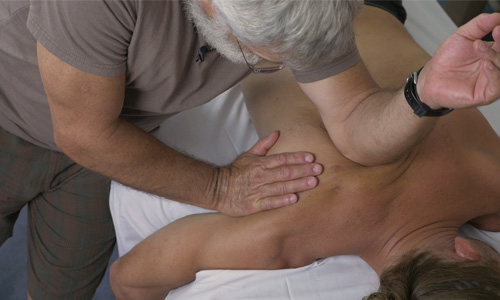
Structural Integration (SI) is a therapeutic approach aimed at optimizing the body’s alignment, movement, and overall function by working with the fascia—the connective tissue that surrounds muscles, bones, and organs.
The biochemist Ida Rolf was the first to introduce it to the bodywork community in the early 1960’s as an approach to integrating the structure of the patient, although her work with patients proceeded that by 30 years. Her idea was to balance the body by manipulating the fascial envelopes and allowing gravity to be the final balancing act. This would then help by improving posture, reducing pain, and enhancing physical and even emotional well-being. It’s less about treating isolated symptoms and more about harmonizing the whole organism.
The work opens tight fascial adhesions that can limit movement. Fascia can become stiff or adhered due to injury, posture, or stress. Manipulating and lengthening it restores its elasticity and ability to glide, allowing for freer movement across the body’s interconnected web. Also, fascial restrictions often contribute to chronic pain. Lessening these restrictions can alleviate discomfort.
Within this approach we are taught about trigger points – which Dr. Janet Travell popularized with her studies on these areas of ischemic tissue. As Rolfers, we are taught where they often occur in the tissue, how to feel them, and how to release those areas to create length and better blood flow to the muscle fibers.
Releasing trigger points reduces the muscle tension that can pull the body out of alignment. Relaxed muscles work more efficiently, supporting balanced movement patterns critical for integration. When fascial manipulation and trigger point therapy are paired, they complement each other powerfully. Pain from trigger points often forces the body to adapt unnaturally. Releasing them lets the system settle into a more neutral, integrated state. Using both approaches can break cycles of tension and dysfunction. And like other forms of bodywork, this work also calms the nervous system by reducing pain signals or stress responses and may enhance the overall sense of well-being.
Together, they offer substantial value in structural integration (SI)—the process of aligning and balancing the body, within gravity, for optimal function and well-being. In essence, fascial manipulation and trigger point therapy are like sculpting tools for structural integration—refining the body’s architecture so it functions as a unified, resilient whole.
If you are interested in learning a very well-structured approach from a historically proven method, we have you covered! Learn more about our course on Structural Integration here.
Leave a Reply